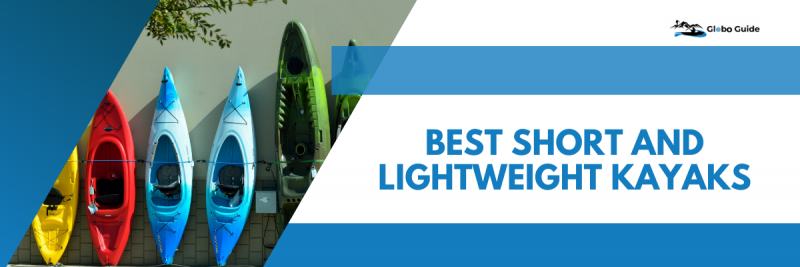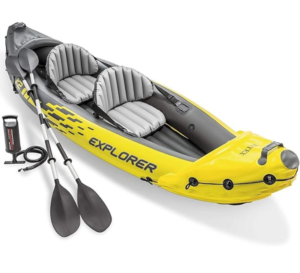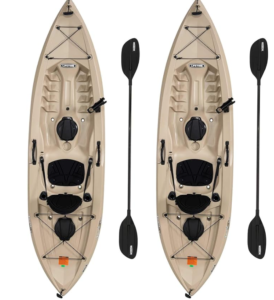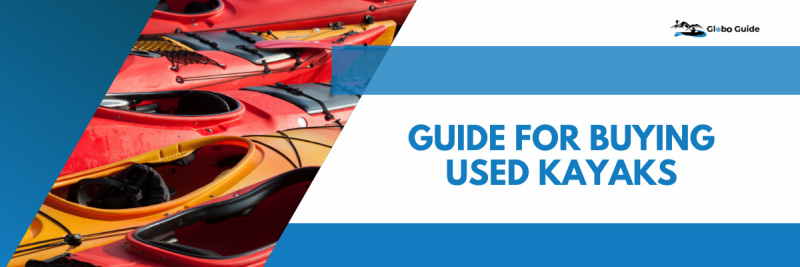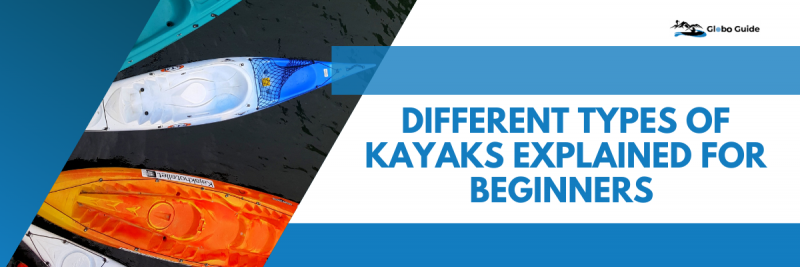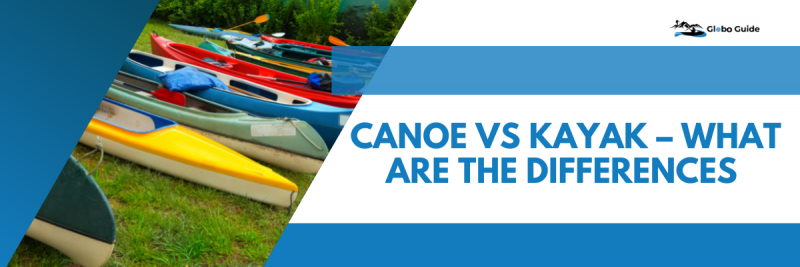When considering lightweight kayaks, inflatable options offer the advantage of weight without sacrificing benefits.
The kayak’s cockpit provides space and comfort while the inflatable I beam floor ensures stability during your paddling adventures. Although it lacks a rear storage area it compensates with a cargo storage located at the dashboard.
Moreover this kayak comes with accessories such as a repair patch, an output manual hand pump for easy inflation and an 84 inch aluminium oar. The Intex Challenger stands out as one of the kayaks in the market today weighing merely 27.2 pounds when deflated. With a weight capacity of 220 pounds it caters to small paddlers perfectly.
Pros
- Its compact size makes it highly portable.
- The removable skeg ensures tracking performance.
- It offers affordability. Is great for beginners.
- Comes complete with a paddle repair kit and hand pump.
Cons
- There is limited onboard storage space.
- It has a load capacity that may not accommodate paddlers.
- On days it can become warm and stuffy inside.
If you love comfort and warmth all the time, then you need a sit-in kayak. The Pelican maxim tops the list of the best small sit-in kayaks.
This ultra-light kayak weighs 36 pounds only. It’s made of RAM-X polyethylene material that ensures durability and lightweight. However, it has a 275-pound weight capacity that locks out larger paddlers.
It has a rear mesh-covered storage platform and a cockpit dashboard. You can place your bottle on the bottle holder at the cockpit dashboard. Also, it has a hatch that’s not waterproof.
The hull design is shallow-v chine. It ensures excellent stability while moving at high speed. However, don’t use abrasives and harsh chemicals when cleaning the kayak.
The kayak’s sitting system has an adjustable padded backrest cousin and a padded seat cushion. The two ensure you are comfortable whenever you are using the kayak.
Pros
● It’s so light you can use one hand to load and carry.
● It has double storage options; the hatch and the rear mesh storage.
● You can wear shorts since it’s a sit-in kayak.
● It’s an all-around performer due to its design and maneuverability.
Cons
● The front storage hatch is not waterproof.
● Its weight capacity locks out large paddlers.
If you want to try out fishing then it would help if you had a kayak that’s comfortable for entry-level kayak fishing. The Lifetime Triton Angler 100 is among the best kayaks for the job. Its hull design is stable and has an integrated skeg for easier angling and tracking performance.
The kayak has different footrest positions. It makes it suitable for different sizes of paddlers. Also, it can hold a weight of up to 275 lb. It has seat pads and an adjustable quick-release seat back that ensures your comfort.
It’s a 10 feet long with a sit-on-top tank and a flat bottom. The beam width is 30.45 inches which boost its stability. Also, you can carry it alone since it weighs 48 lbs. only.
Since it’s a fishing design, it has an adjustable and two flush-mount rod holders. Also, it has a rear tank well with bungee cord lacing where you can fit your gear. When packing, ensure you do not exceed the 275 lbs. weight limit.
It’s made of polyethylene plastic construction. Thus, it may wear and tear more easily than other materials. However, it’s strong enough to withstand a strong impact on stone or hard obstacles.
Pros
● It has an adjustable seat backrest.
● It’s lightweight- under 50 pounds.
● It has great stability due to its flat bottom and length-to-width ratio.
● It has different footrest positions to suit different size paddlers.
Cons
● It has a low load capacity.
● It can be swayed by wind easily.
● The seat clips are flimsy and could fall off easily.
If you want an entry-level kayak that is simple, stable, fast, and fun, then the Perception Zip 9.5 is what you are looking for. It’s 9.5 feet long and 32 inches wide. Also, it weighs 45 pounds with a 250 pounds load capacity, making it easy to carry around.
The sit-on-top kayak design with four footrest positions makes it simple and comfortable to use. Also, it fits all ranges of paddlers since it can fit short and tall people. However, it limits larger paddlers due to its weight limit.
The kayak has molded side handles that make it easy for one person to carry. The storage area is open and large enough to store your supplies. Also, it’s in a position where you can easily access your gear, such as fishing crates, coolers, and dry bags.
However, the design is suitable for calm waters like a lake, slow-moving rivers, and calm oceans. Thus, you can use it when you want a calm environment in the water. It is also equipped with a cup holder to place your beverage as you enjoy the breeze.
Pros
● It has self-draining scupper holes that keep your sailing dry.
● They are super lightweight.
● It has a molded handle for easier portability.
● It has an open cargo area that’s easy to access.
Cons
● It would help if you bought paddles separately.
● The clip-in kayak seats are sold separately.
● The storage capacity is limited. Also, it lacks a dry storage option.
Intex Challenger Kayak
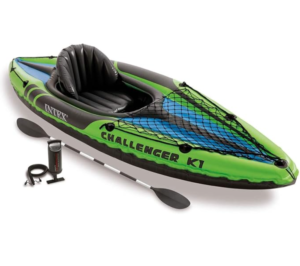
When thinking of small and lightweight kayaks, inflatable options will give you the minimum weight with maximum benefits. It’s made of vinyl material that’s durable and eye-catching. Unlike any kayak, it has a removable skeg which you can use only when you need it.
The cockpit is spacious and comfortable. Also, the inflatable I beam floor ensures stability. Although the kayak lacks a rear storage area, it has a cargo net storage at the dashboard.
The kayak has terrific accessories such as a repair patch, HI output manual hand pump, and an 84-inch aluminum oar.
The Intex challenger is among the lightest kayaks you’ll find in the market. It weighs 27.2 pounds when deflated. However, the weight capacity is 220 pounds making it suitable for medium and small paddlers.
Pros
● It’s compact, ultra-light, and portable.
● The removable skeg ensures the tracking performance is top-notch.
● It’s affordable and beginner-friendly.
● It comes with a paddle, repair kit, and a hand pump.
Cons
● It has limited onboard storage.
● It has a limited load capacity locking out large paddlers.
● It can get warm and stuffy on hot days.
A Guide, for Choosing Compact and Lightweight Kayaks
Finding the kayak can be challenging. You’ll want one that’s short, lightweight and provides leg space during kayaking. In some cases you may even require features like fishing capabilities. Here are the key factors and characteristics to look for in a kayak.
Length
The length of your kayak will depend on your needs and preferences. For a lightweight kayak aim for a length between 8 to 10 feet.
An 8 foot kayak offers manoeuvrability in challenging water conditions, narrow passages and around obstacles. They are especially suitable for women, kids and smaller paddlers. However taller individuals might find them less comfortable. These kayaks provide stability when their length to width ratio is well balanced.
On the other hand a 10 foot kayak offers roominess and onboard storage capacity. They are choices among both short individuals seeking compact kayaks.
At 10 feet long these kayaks strike a balance between manoeuvrability and stability while remaining easy to transport.
Beam Width
Consider the width of your kayak when searching for a lightweight option. The beam width refers to the point of the kayak.
A kayak, with a width of than 30 inches provides stability making it a suitable choice for beginners and anglers. However wider kayaks tend to be slower, less manoeuvrable and less responsive. It is recommended to opt for a kayak with a width between 26-30 inches to strike a balance between stability and manoeuvrability.
When considering the weight of a kayak it is important to choose one that’s small and lightweight for ease of portability. Most compact kayaks weigh more than 50 pounds. People who live far from the lake often prefer kayaks due to their lightness and compactness.
The amount of onboard storage required in a kayak depends on your needs. If you plan on spending days near or on the water, having space for carrying supplies is essential. Additionally if you intend to use your kayak for fishing purposes you’ll need room for storing fishing gear and any catch you may make during the day. However smaller and lightweight kayaks typically require less onboard storage space.
The performance and durability of a kayak are influenced by its construction materials. Kayak hulls are commonly made from either polyethylene plastic or composite materials such as carbon fibre, fibreglass or ABS.
Carbon fiber and fibreglass kayaks are known for their rigidity and durability which translates into enhanced performance and longevity. These materials exhibit resistance, against dents, warping and scratches. Moreover they offer the advantage of being lightweight when compared to kayaks. On the contrary kayaks made of polyethylene plastics tend to be heavier in weight. While they may lack responsiveness and are more prone to warping and scratches they do possess sturdiness that helps them withstand impact from rocks without sustaining damage.
Addressing Puncture Resistance
When it comes to kayaks there is a higher risk of punctures; however such instances are rare under normal usage conditions. In order to minimize this risk further inflatable kayaks are designed with skin layers that provide additional protection against sudden punctures.
Prioritize Comfort
Before finalizing your kayak purchase decision it is essential to ensure that you will feel comfortable while using it. If possible visit a store where you can get into the kayak and personally test its body structure well as leg space. It’s important to find a balance where your leg are not excessively bent for periods in the water as this can become uncomfortable over time. In case you opt for a purchase consider selecting a kayak model that allows you to customize it according to your comfort preferences. Key adjustable features include seats, footplates or footrests and thigh braces.
Understanding Hull Shape
Kayaks come in two hull shapes; V shaped hulls or rounded hulls.
The hull shape of a kayak plays a role, in water conditions. For waters a V shaped hull is ideal as it helps to streamline the flow and cut through turbulence. On the other hand for rivers, lakes and flat coastal water a rounded hull is more suitable for flatwater kayaks.
Now, let’s talk about folding kayaks. They come in two types; those with a rib and an inflatable outer skin or ones with an origami design. Origami kayaks have a material that folds up to create a sturdy outer hull. Both types are options that can meet your needs and preferences.
Stability is a factor to consider when choosing a kayak. While small and lightweight kayaks may be enjoyable to use they can easily overturn in conditions. However some kayak designs are specifically engineered to provide stability in circumstances. Therefore it’s crucial to check the stability specifications before making your purchase.
Another aspect worth considering is edging. The ability of a kayak to tilt and raise one side out of the water. This action creates friction on one side of the kayak making it easier to turn when needed.
Tracking refers to a kayak’s ability to maintain movement while paddling. A kayak with tracking capabilities is easier to control and manoeuvre.
Lastly lets address one asked question; Are short and lightweight kayaks safe? Generally speaking, using kayaks tends to be safer than ones.
What should I wear when I go kayaking?
Wearing a Personal Flotation Device (PFD) is essential when kayaking. Additionally it’s advisable to dress in layers on days as the wind you encounter while kayaking can cool you down. Don’t forget to apply sunscreen and wear shoes. If you plan to tackle waters make sure you have a helmet.
Are kayaks more stable?
The stability of a kayak isn’t determined by its length. The width and shape of the kayak also play roles in its stability. Take into consideration the length to width ratio to assess a kayak’s stability.
What are short kayaks suitable for?
Shorter kayaks, typically ranging from 8 to 12 feet in length are ideal for purposes. They excel in navigating waterways and challenging water terrain. These kayaks offer manoeuvrability. Allow for tight turns. Moreover they are generally considered safer and more stable than kayaks.
Do lightweight kayaks have to be small?
No, a kayak doesn’t need to be small, in order for it to be lightweight. The weight of your kayak is determined by its construction materials and design.
While its true that the majority of kayaks tend to be, on the side the material used is what truly determines their size. However there are exceptions where larger lightweight kayaks can be found. These larger ones may actually offer some advantages over their counterparts in terms of both design and material despite being lighter, in weight overall. When it comes to choosing a kayak, foldable and inflatable designs are often considered the choices.
